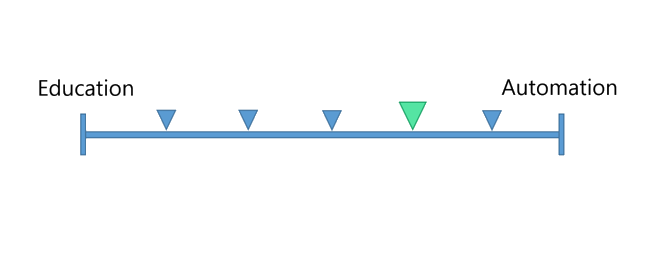“People are dumb” used to be my motto.
OK, that’s an exaggeration. But it did help explain why people didn’t do (or see or understand) what I expected them to. You can put a big green button on the front of your website that says “CLICK HERE,” and some people will still ask, “Where am I supposed to click?”
My colleague uses a more forgiving phrase — “People are busy worrying about something else” — to help explain this phenomenon.
So, if people are busy worrying about something else, how can we expect them to change their ways: to learn a new process, adjust a habit, or remember a to-do? How can we expect their brains to set aside old, entrenched things and accept new, unfamiliar things?
We have two options: education or automation.
As an example, let’s say you’ve just developed a new process for onboarding customers, so you need to introduce this new process to your team.
education
Education means training people (a.k.a. rewiring their brains). So if you choose to implement your new onboarding process through education, then you’ll need to train your team.
For example, you might hold a meeting to hand out Visio flowcharts explaining the new process. Then you’ll practice the process with them a few times. Once it’s adopted, your team will still have a lot of questions and make some mistakes. Eventually everyone will get it, but on a busy or stressful day, they might forget some steps. Whenever they come back from vacation, they’ll need a refresher on the entire process. Sometimes they’ll feel annoyed that their brains remember the old process, yet they’re expected to follow the new process.
All in all, it’s hard to rewire people’s brains. Not impossible, just hard.
automation
Or, if you choose to implement your new process through automation, then you’ll need to build an automatic workflow.
For instance, when a customer fills out their billing information on your website, a card can be automatically generated in Trello through Zapier or an API integration. This card can have the customer’s information and an automatic checklist, so your team knows exactly what steps are next. After they check every box on that card (such as “Create customer profile” and “Send welcome email”), the card can be moved automatically to a new Trello board for onboarded customers. Done.
In this case, it’s nearly impossible to miss a step or make a mistake, and there was no need for brain rewiring. Your team just needs to know to check Trello — and they can set an automatic daily reminder for that.
the spectrum
In reality, you’ll rarely come across a situation that requires all education or all automation. More likely, the best solution will lie somewhere on the spectrum between the two.
Even with a beautifully automated workflow, you’ll still need a degree of education, since your team will need to training on how to interact with the automation. So, embrace automation where you can and accept that education may still play a role.
———————
Action items:
〉 Identify a process (or process step) that you can automate.
〉 Research automation tools (like Zapier, Trello, Toggl).
〉 Try out the tools! Adjust as needed! Make your life easier!

